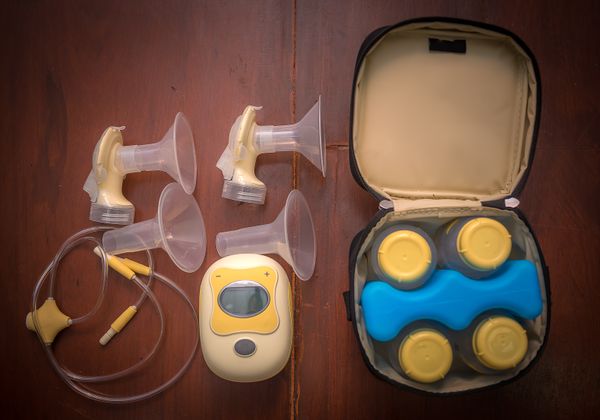We hope you've decided to at least try breastfeeding. Even if you only nurse your baby for a few days or weeks, that early milk, called colostrum, provides an important source of antibodies to protect against disease as Baby's own immune system develops during the first year.
But did you know that breastfeeding benefits you, too?
- It helps your uterus return to its pre-pregnancy size and reduces post-delivery bleeding.
- It makes it easier to lose those pregnancy pounds (you burn up to 500 extra calories a day nursing).
- It may reduce your risk of postpartum depression and breast and ovarian cancer.
- It can delay the return of your period (although you should still use some form of birth control when you resume intercourse).
- It saves money (no formula!).
Breastfeeding is a learned process; none of us (not even Baby) are born knowing how to do it. To improve your chance of success:
- Try to breastfeed within the first hour of birth. This helps your uterus contract and provides that valuable colostrum. Also ask to have Baby room in with you at the hospital so you can feed on demand.
- Have a nurse or lactation consultant check how Baby latches on while you're still in the hospital. While it might be uncomfortable when Baby latches on, it shouldn't be painful. If it hurts badly enough to make you grimace every time, then you may not have the right position.
- Prepare for your milk to come in. This occurs on about the third or fourth day after birth. You'll know it's happened because your breasts suddenly increase several cup sizes! Speaking of which, make sure you have several well-fitting nursing bras, and don't forget to pack one in your hospital bag.
- Plan to breastfeed about eight to 12 times in every 24-hour period. Your baby is good at giving hunger signals: rooting around searching for your nipple; putting his hand in his mouth; and looking increasingly alert. Always feed on demand.
- Try not to introduce a bottle or other nipples, including pacifiers, until breastfeeding is well established. The thrusting motion required to nurse is different from that required to suck a nipple, and Baby could get confused.
- Stay hydrated to ensure your body can make enough milk. A good idea is to sip from a glass of water when nursing.
- Nurse in a calm environment to help your milk let down. After a while, all it will take for your milk to let down is unhooking your bra for your baby, or even just hearing any infant cry.
Common Breastfeeding Challenges
Here are the most common breastfeeding-related problems and how you can avoid them:
- Sore and cracked nipples. Check the position of the baby when she latches on; smooth lanolin over your nipples after each nursing session; and let your nipples air dry after each nursing session. Also, alternate which breast you start on for each session. Put a safety pin or plastic bracelet on your wrist on the side of your bra that was just used to help you remember. And limit nursing to 5 to 10 minutes on each side initially until your nipples toughen up (just a few days). You should also not hear any clicking or sucking sound. If you do, the baby isn't positioned right. Bring Baby closer to you, and hold his head firmly so his mouth covers as much of the areola as possible.
- Engorgement (overly full breasts) or blocked milk duct. Warm compresses, letting warm water run over your breasts in the shower, or laying cabbage leaves on your breasts can help relieve some of the pressure. You can also try pumping some milk between feedings.
- Mastitis or breast infection. If you feel like you have the flu and one breast is red, hot and sore, you probably have mastitis. You'll likely need an antibiotic to clear up the infection. In the meantime, keep nursing and/or pumping on that side as much as you can, even though it hurts. To prevent mastitis, make sure you empty your breasts regularly. If you do take antibiotics, add a probiotic (good bacteria such as lactobacillus) supplement, or eat a container of live culture yogurt every day, to help prevent the next complication: thrush.
- Thrush. Thrush is a fungal infection that can form on the breast and be passed between your breast and the baby's mouth. Overly moist breasts, sore or cracked nipples, following a diet high in sugar or yeasty foods or taking antibiotics, birth control pills or steroids can all throw your body's natural yeast levels out of control and lead to thrush. Symptoms are very sore nipples, achy or painful breasts or pink, flaky, shiny, itchy or cracked nipples. Your baby may have little white spots in her mouth, or a diaper rash that won't heal. You will need to treat both your breasts and the baby's mouth with a prescription antifungal or with the over-the-counter antifungal gentian violet. To prevent thrush, air-dry your nipples, use nipple pads in your bra, wear a clean bra every day, and reduce the amount of sugar and yeasty products in your diet.
Increasing Milk Supply
Breastfeeding is a basic supply-and-demand activity. The more you nurse, the more milk your body makes. So when your baby goes through a growth spurt and seems to be nursing all the time, keep in mind she's signaling your body to up the milk production for her new nutritional needs.
Get everything you need to know about breastfeeding by clicking here.
- How to Wean Your Child From Breastfeeding ›
- 5 Things That Helped Boost My Breast Milk Supply ›
- Overcoming Breastfeeding Challenges as a New Mom ›
- Breastfeeding Tips For Working Moms ›
- When My Breasts Didn't Work, I Nursed My Baby Anyway ... ›
- La lactancia y el cáncer de mama - HealthyWomen ›
- Breastfeeding and Breast Cancer - HealthyWomen ›







